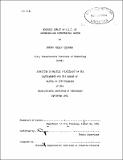Economic impact of M.I.T. on Cambridge and Metropolitan Boston
Author(s)
Finberg, Irving William
DownloadFull printable version (11.32Mb)
Alternative title
Economic impact of MIT on Cambridge and Metropolitan Boston
Economic impact of Massachusetts Institute of Technology on Cambridge and Metropolitan Boston
Other Contributors
Massachusetts Institute of Technology. Dept. of City Planning.
Advisor
John T. Howard.
Terms of use
Metadata
Show full item recordAbstract
This thesis investigated the economic impact of the Massachusetts Institute of Technology on its host city, Cambridge, and upon the Boston Metropolitan Area. The primary purpose was to develop sufficient information about the operation of a large educational institution to enable a city planner to study or forecast the direct and indirect impacts of a school on its locality and to measure the impact. There was a corollary purpose to the thesis. It was to examine the pattern of M.I.T.'s primary economic impact within the Metropolitan Area. The thesis analyzed all municipal costs and revenues to determine whether or not the institution was a financial asset to the city. It also investigated many, and hopefully all, other tangible and intangible benefits to determine the net benefit to Cambridge and the Boston Standard Metropolitan Statistical Area which was used as the area of study. The result of the investigation proved that M.I.T. benefited the City of Cambridge financially as well as by intangibles. The research verified the assumption that the direct and indirect impacts are felt primarily in the communities closest to the Institute. The primary impact was the result of employment and expenditures. The secondary benefits to the area resulted from the large flow of money from outside and by the multiplier effects of both M.I.T. and its family's expenditures. The examination of the pattern of impact disclosed that the student impact was greatest in Cambridge and nearby Boston. However, that of the staff and faculty and other employees was spread through the area but essentially in Cambridge and the suburban ring.
Description
Thesis (M.C.P.)--Massachusetts Institute of Technology, Dept. of City Planning, 1964. Includes bibliographical references (leaves 98-101).
Date issued
1964Department
Massachusetts Institute of Technology. Department of Urban Studies and PlanningPublisher
Massachusetts Institute of Technology
Keywords
City Planning.